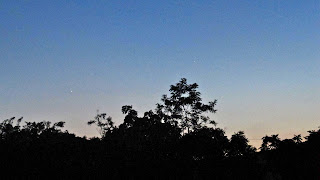 July 1 — July 20, 4:30 a.m.: Bright Jupiter and Brilliant Venus glide among the stars of the Pleiades and Hyades star clusters.
July 1 — July 20, 4:30 a.m.: Bright Jupiter and Brilliant Venus glide among the stars of the Pleiades and Hyades star clusters.
July 4, 11 p.m.: The Earth reaches its farthest point from the sun, 94.5 million miles.
July 14 and 15, 4:30 a.m.: The crescent moon joins Jupiter and Venus. Should be a very dramatic sky sight.
July 24: The crescent moon forms a distorted rectangle with Mars, Saturn, and Spica.
July 25: The moon glows to the left of Spica, forming a right triangle with it and Saturn.
The Milky Way
Scan the Milky Way with binoculars. You will be rewarded with many celestial delights: star clusters, nebulae, and dark fields that are sparse of stars next to fields full of stars.
Such is our view from Earth...
Such is our view from Earth...








